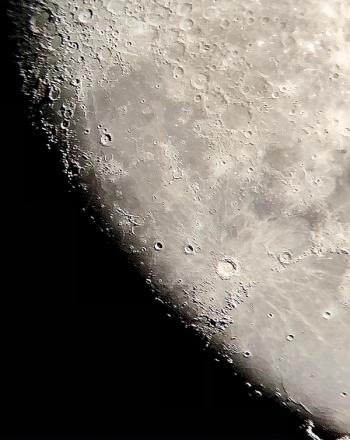
In a recent study, researchers used laser-induced breakdown spectroscopy (LIBS) to examine the complexities of plasma conditions, focusing on the addition of matrix elements.

In a recent study, researchers used laser-induced breakdown spectroscopy (LIBS) to examine the complexities of plasma conditions, focusing on the addition of matrix elements.

In a recent study, collaborative spectroscopic methods, such as LIBS-Raman, were used for detecting and combatting heavy metal lead contamination in wheat seedlings, revealing critical insights for food security and human health.

At SciX, Johannes Pedarnig of Johannes Kepler University will be recognized as the 2023 SAS and Applied Spectroscopy William F. Meggers Award recipient. Here's a summary of the award session.

At SciX 2023, Ismail Boyaci from The Ohio State University unveiled the transformative potential of laser-induced breakdown spectroscopy (LIBS) in food analysis, offering rapid and precise solutions to enhance food safety and quality. LIBS emerges as a game-changing tool, poised to reshape how we scrutinize and safeguard our food supply.

A recent investigation of the optical emission of plasma on industrial steel samples using LA-SD-OES and LIBS revealed new findings about the oxide composition of the slag layer.

Understanding gallstone formation requires examining their elemental composition. Here, EDS and LIBS were used with PLS-DA to quantify elements found in human gallstones.

India's Chandrayaan-3 mission is the first successful attempt to land on the moon’s southern region and has uncovered several noteworthy discoveries on the lunar south pole using laser-induced breakdown spectroscopy (LIBS) and other spectroscopic techniques.

In a recent study, researchers used molecular and elemental spectroscopic techniques, such as LIBS, Raman spectroscopy, and FT-IR spectroscopy, to characterize silicate gems found in ancient Egyptian mines.

Scientists used laser induced breakdown spectroscopy (LIBS) to analyze the safety of food.

A recent study explains how laser-induced breakdown spectroscopy (LIBS) is better suited for rapidly quantifying heavy metals in plastics than traditional methods such as inductively couple plasma–mass spectrometry (ICP-MS) and atomic absorption spectroscopy (AAS).

A recent study shows how the LIBS approach can be used to measure the magnetic field near the surface of plasma-facing components (PFCs).

A recent study tests new systems meant to better analyze components in the semiconductor industry and pave the way for better electronic devices.

Scientists at West Virginia University have created a new LIBS system meant to better identify the components of gunshot residue at crime scenes and in evidence.

A new study showcases a newly developed automated mineral classification workflow based on laser-induced breakdown spectroscopy (LIBS) mapping, enabling fast and accurate identification of minerals in geological samples.

New research demonstrates the potential of combining LIBS and EPMA for distinguishing and characterizing uranium mineralizations, opening new avenues for environmental protection and ore genesis studies.

Researchers have developed a transfer learning-assisted laser-induced breakdown spectroscopy (LIBS) method to identify geographical origins of crops with an impressive accuracy by incorporating deep adaptation networks.

A research group has utilized laser-induced breakdown spectroscopy (LIBS) to analyze the contamination profiles of Frascati Tokamak Upgrade (FTU) limiter tiles after exposure to fusion plasma. The study revealed the presence of various contaminants, including boron, calcium, lithium, and eroded materials, providing valuable insights into the distribution and effects of fusion plasma on the surfaces of these tiles.

A team of researchers have investigated the early dynamics of laser-induced plasma and cavitation bubbles in water, enhancing our understanding of underwater laser-induced breakdown spectroscopy (LIBS) and the critical role of bubble-plasma interaction in characterizing laser-induced plasma in water.

Researchers have developed an advanced method using laser-induced breakdown spectroscopy (LIBS) for sensitive and accurate detection of nitrogen in simulated Martian soil.

By evaluating different pretreatment techniques, such as sieving and milling, the study highlights the significance of achieving sample homogeneity for precise analysis of soil texture and organic carbon content.

Researchers have successfully applied laser-induced breakdown spectroscopy (LIBS) technology to quantitatively detect raw ore turquoise, a key ingredient in Tibetan medicines.

Researchers have developed a new methodology using laser-induced breakdown spectroscopy (LIBS) and the support vector machine model (SVM) to classify defects in metal-additive manufacturing (AM) parts.

New research demonstrates significant progress in accurately measuring hydrogen on airless planetary bodies using laser-induced breakdown spectroscopy (LIBS). These findings provide valuable insights into the spatial distributions and depth profiles of hydrogen-bearing materials, addressing previous uncertainties in remote-sensing observations and opening doors for future space exploration missions.

A researcher group has utilized laser-induced breakdown spectroscopy (LIBS) to develop a method for food authentication and quality analysis.

Researchers have developed advanced laser-induced breakdown spectroscopy (LIBS) methods for rapid element quantification in alloy particles, aiding in the efficient analysis and identification of their source materials.